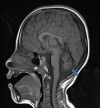Gillespie's Syndrome Phenotype in A Patient with a Homozygous Variant of Uncertain Significance in the ITPR1 Gene
- PMID: 35574166
- PMCID: PMC9103597
- DOI: 10.1080/01658107.2021.1982991
Gillespie's Syndrome Phenotype in A Patient with a Homozygous Variant of Uncertain Significance in the ITPR1 Gene
Abstract
A 10-year-old girl presented with left-eye esotropia and fixed mydriasis. Previously, she had been diagnosed with cerebellar ataxia and mild intellectual disability. Her parents were healthy. She was found to have partial aniridia of the pupillary sphincter bilaterally. A next-generation sequencing test for the inositol 1,4,5-trisphosphate type 1 receptor (ITPR1) gene was performed, revealing a previously unreported homozygous variant of uncertain significance at c.7610. Computational (In Silico) predictive models predicted this variant to be disease causing. With the arrival of DNA sequencing, aniridia can be genetically classified. In this case report, we present a patient with phenotypic features of Gillespie's syndrome with a homozygous variant in the ITPR1 gene that has not previously been reported.
Keywords: Aniridia; Gillespie syndrome; ITPR1 gene; cerebellar ataxia.
© 2021 Taylor & Francis Group, LLC.
Conflict of interest statement
The authors reveal they have no conflict of interests. This report was not financed by any organisation.
Figures


Similar articles
-
Phenotypic Spectrum and Natural History of Gillespie Syndrome. An Updated Literature Review with 2 New Cases.Cerebellum. 2024 Dec;23(6):2655-2670. doi: 10.1007/s12311-024-01733-7. Epub 2024 Aug 23. Cerebellum. 2024. PMID: 39177731 Free PMC article. Review.
-
Gillespie's Syndrome with Minor Cerebellar Involvement and No Intellectual Disability Associated with a Novel ITPR1 Mutation: Report of a Case and Literature Review.Neuropediatrics. 2019 Dec;50(6):382-386. doi: 10.1055/s-0039-1693150. Epub 2019 Jul 24. Neuropediatrics. 2019. PMID: 31340402
-
Gillespie syndrome in a South Asian child: a case report with confirmation of a heterozygous mutation of the ITPR1 gene and review of the clinical and molecular features.BMC Pediatr. 2018 Sep 24;18(1):308. doi: 10.1186/s12887-018-1286-5. BMC Pediatr. 2018. PMID: 30249237 Free PMC article.
-
A novel de novo intronic variant in ITPR1 causes Gillespie syndrome.Am J Med Genet A. 2021 Aug;185(8):2315-2324. doi: 10.1002/ajmg.a.62232. Epub 2021 May 5. Am J Med Genet A. 2021. PMID: 33949769 Free PMC article.
-
Missense mutation in the ITPR1 gene presenting with ataxic cerebral palsy: Description of an affected family and literature review.Neurol Neurochir Pol. 2017 Nov-Dec;51(6):497-500. doi: 10.1016/j.pjnns.2017.06.012. Epub 2017 Jul 8. Neurol Neurochir Pol. 2017. PMID: 28826917 Review.
Cited by
-
Phenotypic Spectrum and Natural History of Gillespie Syndrome. An Updated Literature Review with 2 New Cases.Cerebellum. 2024 Dec;23(6):2655-2670. doi: 10.1007/s12311-024-01733-7. Epub 2024 Aug 23. Cerebellum. 2024. PMID: 39177731 Free PMC article. Review.
-
Congenital anterior segment ocular disorders: Genotype-phenotype correlations and emerging novel mechanisms.Prog Retin Eye Res. 2024 Sep;102:101288. doi: 10.1016/j.preteyeres.2024.101288. Epub 2024 Aug 2. Prog Retin Eye Res. 2024. PMID: 39097141 Review.
References
-
- De Silva D, Williamson KA, Dayasiri KC, et al. Gillespie syndrome in a South Asian child: a case report with confirmation of a heterozygous mutation of the ITPR1 gene and review of the clinical and molecular features. BMC Pediatr. 2018; 18(1):308. Published September 24, 2018. doi:10.1186/s12887-018-1286-5. - DOI - PMC - PubMed
Publication types
LinkOut - more resources
Full Text Sources
